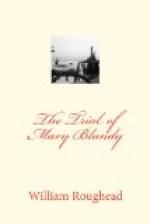a private manner” for some months, and in November
the bride returned to her family, while the captain
went to London to resume his regimental duties.
They corresponded regularly by letter. Cranstoun
wrote to his own and the lady’s relatives, acknowledging
that she had been his wife since May, but insisting
that the marriage should still be kept secret; and
on learning that he was likely to become a father,
he communicated this fact to my Lord, his brother.
Lady Cranstoun invited her daughter-in-law to Nether
Crailing, the family seat in Roxburghshire, there
to await the interesting event, but the young wife,
fearing that Presbyterian influences would be brought
to bear upon her, unfortunately declined, which gave
offence to Lady Cranstoun and aroused some suspicion
regarding the fact of the marriage. At Edinburgh,
on 19th February, 1745, Mrs. Cranstoun gave birth
to a daughter, who was baptised by a minister of the
kirk in Newbattle, according to one account, in presence
of members of both parents’ families; and, by
the father’s request, one of his brothers held
her during the ceremony. In view of these facts
it must have required no common effrontery on the
part of Cranstoun to disown his wife and child, as
he did in the following year. The country being
then in the throes of the last Jacobite rising, and
his wife’s family having cast in their lot with
Prince Charlie, our gallant captain perceived in these
circumstances a unique opportunity for ridding himself
of his marital ties. The lady was a niece of John
Murray of Broughton, the Prince’s secretary who
served the cause so ill; her brother, the reigning
baronet, was taken prisoner at Culloden, tried at
Carlisle, and sentenced to death, but owing to his
youth, was reprieved and transported instead; so Cranstoun
thought the course comparatively clear. His position
was that Miss Murray had been his mistress, and that
although he had promised to marry her if she would
change her religion for his own purer Presbyterian
faith, and as the lady refused to do so, he was entirely
freed from his engagement. With cynical impudence
he explained his previous admission of the marriage
as due to a desire to “amuse” her relatives
and save her honour. In October, 1746, his wife,
by the advice of her friends and in accordance with
Scots practice, raised in the Commissary Court at
Edinburgh an action of declarator of marriage against
her perfidious spouse, and the case was still pending
before the Commissaries when Lord Mark Kerr, as we
have seen, “gave away” his grand-nephew
to the Blandys.
The old attorney was justly incensed at the unworthy trick of which he had been the victim. He had designed, indeed, on his own account, a little surprise for his son-in-law in the matter of the mythical dower, but that was another matter; so, in all the majesty of outraged fatherhood, he sought an interview with his treacherous guest. That gentleman, whose acquaintance with “tight corners” was, doubtless, like Mr. Waller’s knowledge of London,




